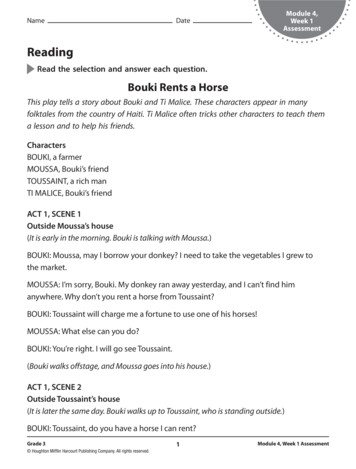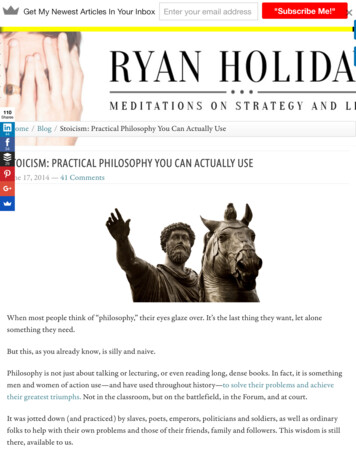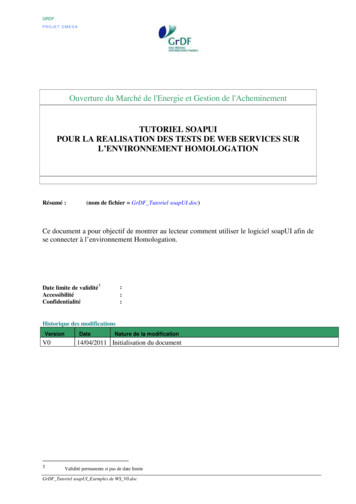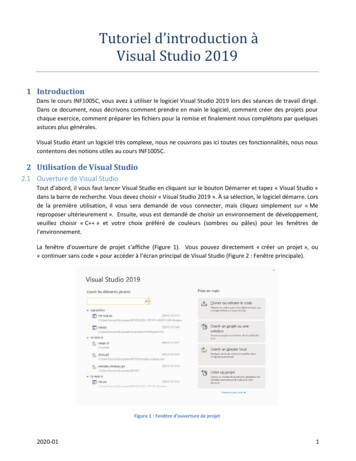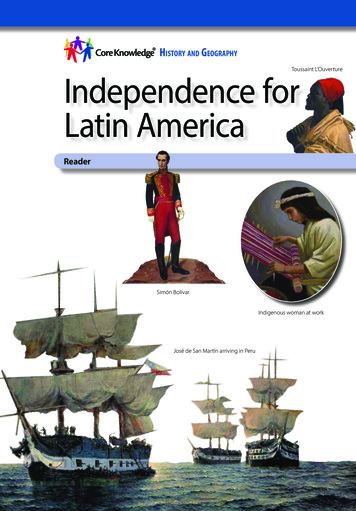
Transcription
History and GeographyToussaint L’OuvertureIndependence forLatin AmericaReaderSimón BolívarIndigenous woman at workJosé de San Martín arriving in Peru
THIS BOOK IS THE PROPERTY OF:STATEBook No.PROVINCEEnter informationin spacesto the left asinstructed.COUNTYPARISHSCHOOL DISTRICTOTHERISSUED TOYearUsedCONDITIONISSUEDRETURNEDPUPILS to whom this textbook is issued must not write on any page or markany part of it in any way, consumable textbooks excepted.1. T eachers should see that the pupil’s name is clearly written in ink in thespaces above in every book issued.2. The following terms should be used in recording the condition of thebook:New; Good; Fair; Poor; Bad.
Independencefor Latin AmericaReader
Creative Commons LicensingThis work is licensed under aCreative Commons Attribution-NonCommercial-ShareAlike4.0 International License.You are free:to Share—to copy, distribute, and transmit the workto Remix—to adapt the workUnder the following conditions:Attribution—You must attribute the work in thefollowing manner:This work is based on an original work of the CoreKnowledge Foundation (www.coreknowledge.org) madeavailable through licensing under a Creative CommonsAttribution-NonCommercial-ShareAlike 4.0 InternationalLicense. This does not in any way imply that the CoreKnowledge Foundation endorses this work.Noncommercial—You may not use this work forcommercial purposes.Share Alike—If you alter, transform, or build upon this work,you may distribute the resulting work only under the same orsimilar license to this one.With the understanding that:For any reuse or distribution, you must make clear toothers the license terms of this work. The best way todo this is with a link to this web /4.0/All Rights Reserved.Core Knowledge , Core Knowledge Curriculum Series ,Core Knowledge History and Geography and CKHG are trademarks of the Core Knowledge Foundation.Trademarks and trade names are shown in this bookstrictly for illustrative and educational purposes and arethe property of their respective owners. References hereinshould not be regarded as affecting the validity of saidtrademarks and trade names.ISBN: 978-1-68380-339-3Copyright 2018 Core Knowledge Foundationwww.coreknowledge.org
Independencefor Latin AmericaTable of ContentsChapter 1Revolutions in America . . . . . . . . . . . . . . . . . . . . . . . . . 2Chapter 2Toussaint L’Ouverture and Haiti . . . . . . . . . . . . . . 10Chapter 3Mexico’s Fight for Independence . . . . . . . . . . . . . 26Chapter 4Mexico After Independence . . . . . . . . . . . . . . . . . . . 40Chapter 5Simón Bolívar the Liberator . . . . . . . . . . . . . . . . . . . 52Chapter 6Revolution in the South . . . . . . . . . . . . . . . . . . . . . . . . 68Chapter 7Brazil Finds Another Way. . . . . . . . . . . . . . . . . . . . . . . 78Glossary. . . . . . . . . . . . . . . . . . . . . . . . . . . . . . . . . . . . . . . . . . . . . . . . . . . . . . . 88
Independence for Latin AmericaReaderCore Knowledge History and Geography
Chapter 1Revolutions in AmericaThe Struggle for Independence WhyThe Big Questiondo we celebrate Independence DayWhy did Europeanon the Fourth of July? Well, it is thecolonies in North andday that represents when the originalSouth America wantthirteen English colonies declared theirtheir freedom?independence from Great Britain in 1776.Declaring independence was one thing, but achieving it wasnot quite as easy. The Declaration of Independence led to abloody seven-year war between Great Britain and the colonies.As you know, the colonies won that war and created the United States. What youmay not know is that most of the other countries in North and South Americawere once colonies and also declared their independence from colonial powers.They too revolted and fought wars to become free. Many struggled to gainindependence from Spain, but others declared independence from France,Portugal, and the Netherlands. (The people of the Netherlands are commonlyreferred to as the Dutch.) Each of these countries has a national holiday when itscitizens celebrate their independence, just as Americans do on the Fourth of July.In this book, you will read about these countries—located in a part of the worldcalled Latin America—and how they won their freedom.2
Colonies in Latin America, 170030 NUnited StatesATLANTICOCEANGulf ofMexico HavanaMexicoHaitiCuba20 NBelizeMexico CityGuatemelaHonduras JamaicaCaribbean SeaNicaraguaCaracasEl SalvadorCosta Rica10 NDominicanRepublicVenezuelaPanamaGuyana SurinameFrench GuianaBogotáPACIFIC OCEANColombiaEcuadorQuitoGalapagos Islands(Ecuador)0 OlindaBrazilPeru10 S20 S30 SSpanish, Portuguese,French, English, and Dutchcolonies were establishedin the Americas by 1700.The region of Latin Americaincludes Central and SouthAmerica. The name, “LatinAmerica”, comes from theinfluence of the Spanish,French, and Portuguesecolonizers, and from theirLatin based languages.Latin was the language ofancient Rome. The areascontrolled by Spain at thistime were called New Spain.SOUTHAMERICALimaCuzcoBoliviaParaguaySão PauloChileArgentinaSantiagoBuenosAiresUruguayW40 S50 S110 W100 W90 WFalkland Islands(U.K.)080 WESNo coloniesFrench coloniesSpanish coloniesPortuguese coloniesDutch coloniesModern borders120 WN70 W60 W50 W1,500 Miles40 W30 W20 W10 W3
Why Did the Revolutions Happen?Imagine what it would have been like to live in Latin America in the 1700s.Society was divided into social classes, with Europeans having a great dealof power, and native peoples and enslaved people having little or no power.People were born into a class, and for most of them,it was difficult to move beyond that class. If you wereVocabularya French plantation owner, you would have littleclass, n. a groupof people withthe same social oreconomic statusto complain about, because you were in charge.And the same would have been true for a Spanisharistocrat who was born in Spain and moved toone of the Spanish colonies in Latin America. Butif you were a member of the lower classes, it was adifferent story. (It’s important to note, however, thatthe class system in Latin America was not quite asrigid as the one that existed in Europe, which wasbased on birth. There, no matter how rich you mightbecome, if you were not born of the nobility, youaristocrat, n. aperson of the upperor noble class whosestatus is usuallyinheritedindigenous, adj.native to aparticular region orenvironmentwould never be accepted as one of them.)Let’s examine the class system in Spanish Latin America in the 1700s. In theSpanish colonies, the people considered to be the highest class were bornin Spain and then moved to the Americas. These people made up only a tinypercentage of the population, but they held most of the power, enjoyed specialprivileges, and controlled most of the wealth.Creoles (/kree*ohlz/) were the next highest social class. Creoles were peoplewho were born in America but whose parents or ancestors had been bornin Spain. Some of the Creoles were rich and well educated, but they werenot often given important jobs in government. The Creoles resented theSpaniards because of the limitations they imposed on them.Below the Creoles were the mestizos (/mes*tee*zohs/) who were partly indigenousand partly Spanish. Some of these people worked as craftspeople or shop4
owners. Others held minor jobs in the Church or worked as managers in minesor on plantations. Few were rich, and few had the opportunity to improve theirlives. Nevertheless, mestizos had better lives than the truly indigenous peopleand the enslaved people who occupied the classes below them. Within thissocial structure, there were a significant number of free people of color—thoseof African descent—who lived independent lives, had businesses, and farmed.Indigenous people were among the most oppressed people in Spanish Latin America.5
In most colonies, the truly indigenous people madeup the great majority of the population. Somecontinued to live in the mountains, forests, andplaces farther away from the colonial settlements.These rural people had little to do with the colonialsociety. But others lived in missions founded bySpanish priests. These indigenous people workedas personal servants or as laborers on plantations.Some also worked in the mines. Almost all of themwere poor and had few rights. Occasionally, theywould rise up, and some of the rebellions had aVocabularymission, n. asettlement builtfor the purpose ofconverting NativeAmericans toChristianitypriest, n. a personwho has the trainingor authority to carryout certain religiousceremonies or ritualscertain degree of success.Finally, there were the enslaved Africans. The Spanish had used enslavedAfricans in their American colonies since the early 1500s. However, the use ofenslaved Africans was not widespread in the Spanish colonies. In 1800, therewere about eight hundred thousand enslaved Africans in all of SpanishAmerica, with many living on the islands of the Caribbean. Nevertheless, theywere the most oppressed group of people.The lower three classes made up the vast majority of people living inSpanish America. If you belonged to one of these classes, you were almostcertainly poor. You would have had few rights and little chance to get aneducation. Worst of all, there was little hope that things would ever changefor you, your children, or your grandchildren.The details of the class system varied from colony to colony. French andPortuguese colonies differed from Spanish colonies, and Spanish coloniesdiffered from each other. The Dutch had their own class system, too.However, the general situation was much the same all over Latin America:the Europeans were on top and the indigenous peoples and enslaved peoplewere on the bottom.6
Foreign InfluencesNow imagine how the people ofSpanish America felt when they heardthe ideas of John Locke, Voltaire, andthe other writers of the Enlightenment.What would they have thoughtwhen they learned of the successfulAmerican Revolution? This revolutiongave the people of the United Statesindependence, freedom, justice, andopportunities that most people in LatinAmerica had never dreamed of having.Then there was the French Revolution,which began in 1789. Here was anothercase in which people rose up against theirJohn Locke believed those who servedin government and those in positionsof power had a responsibility to protectthe natural rights, or liberties, of thepeople. If they failed to do so, hebelieved that the people had a right todemand new leaders.rulers and demanded rights. The people of Latin America saw these events anddrew inspiration from them. They began to demand their own rights.Events in France influenced the Latin American independence movementin another way, too. In 1799, the revolutionary military leader NapoleonBonaparte (/boh*nuh*part/) came to power in France. By 1808, he controlledItaly, the Netherlands, part of Germany, and many European territories. Inthat year, he invaded Spain and Portugal. Napoleon removed the Spanishking and put his brother Joseph Bonaparte on the Spanish throne. This eventhad an unusual result. It allowed the Spanish colonies in America to declareindependence from Spain without having to be disloyal to their deposedSpanish king.Revolution broke out throughout Spain’s American colonies in 1810. It usuallybegan within the local governments in each colony. These governments werein the hands of cabildos (/kah*bihl*dohz/), or city councils.7
The Spanish king, Charles IV, was removed from power in 1808.8
These city councils decided the time was right to proclaim their independencefrom Spain. Caracas, the capital of Venezuela, started the revolution inApril 1810. Buenos Aires, the capital of Río de la Plata, which includespresent-day Argentina, Uruguay, Paraguay, and Bolivia, followed in May.Next came Bogotá, the capital of New Granada in July. Quito (/kee*toh/),which became the capital of Ecuador (/ek*wuh*dawr/), rebelled in August,and Santiago, the capital of Chile, joined the revolutionary movement inSeptember. The big exception to this trend of city councils leading the fightfor independence was in Mexico, where a Creole priest named Miguel Hidalgoy Costilla (/mee*gel/hih*dal*go/ee/kohs*tee*yah/) started Mexico’s fight forindependence in September 1810.The people you will learn about in this book, such as Toussaint L’Ouverture(/too*san/loo*ver*toor/) of Haiti, Simón Bolívar (/see*mawn/boh*lee*vahr/)of Venezuela, and José de San Martín (/hoh*say/de/sahn/mahr*teen/) ofArgentina, wanted to create governments based on the same principlesas those of the U.S. government. Many of these leaders had been to theUnited States or Europe. They wanted governments that would givethe people of Latin America those same rights of freedom, justice, andopportunity. They believed that revolution was the only way to get whatthey wanted.9
Chapter 2Toussaint L’Ouvertureand HaitiThe Night of Fire It was August 1791.The Big QuestionIn St. Domingue (/san/duh*mang/), theHow would yousound of drums echoed from mountaindescribe the battleto mountain and across the plain.for freedom thatSt. Domingue was a French colony in theoccurred in Haiti?Caribbean, on the island of Hispaniola(/hiss*pahn*yoh*luh/). Its French plantation owners heardthe dim sound of the drumbeats in the distance but were notworried. They had heard them before.10
This painting shows the city of Cap-Haïtien, which was knownat the time as Cap-François (/frahn*swah/).11
It was no secret that escaped enslaved Africans hid in the mountains. Therethey practiced their ancient African religion called voodoo.The drums really were celebrating a voodoo rite, but it was not the usualceremony the planters thought it was. The enslaved Africans were plottinga rebellion!Deep in the mountains an enslaved African worker and voodoo priest namedBoukman led the ceremony. Around him were gathered the leaders of theenslaved people from across the Plain du Nord (/plen/duh/nor/), the northernplain of Haiti.Boukman was not a field hand like most enslaved people. He had been aforeman who managed field workers. Later, he worked his way up to being acoachman. That was an important job on a plantation. Moreover, Boukmanwas a huge man who commanded respect through size alone. All eyesfollowed Boukman as he gave his instructions and inspired his followers tohave courage.One week later, on August 22, 1791, some fifty thousand enslaved peoplerose up and swept across the Plain du Nord. Armed with machetes(/muh*shet*eez/) and scythes (/sythz/), the enslaved people moved inan unstoppable wave across the land. They killedplantation owners and their families. They set fireVocabularyto houses and barns and even to crops. The firesforeman, n. aperson who overseesother workersspread, covering the horizon and sweeping acrossfields, plantations, and forests. The night becameas bright as day. The rich plantations were inruins, and the army of enslaved people controlledthe countryside.Over the next few days, this army destroyed allthe plantations on the Plain du Nord. Most of thesurviving French took shelter in Cap-Haïtien—thecapital of the province.12coachman, n. aperson who drivesa coach, a type offour-wheeled vehicledrawn by a horseprovince, n. an areaor region similar toa state
This image shows the rebellion that broke out in the French colony of St. Domingue.The night the rebellion began became known as the Night of Fire. It markedthe beginning of a thirteen-year struggle to turn the colony of St. Domingueinto the country of Haiti, the first black republic in the world and the firstindependent state in Latin America. It began as a rebellion against slavery.Before 1791Before August 1791, when the revolution began, St. Domingue was the richestcolony in the Caribbean. A century earlier, French planters had taken over thewestern third of the island of Hispaniola from the Spanish.13
During the 1700s, tens of thousands of African peoples were captured andenslaved as a result of warfare between neighboring nations. They werethen traded to and brought in chains to North and South America and theCaribbean. Many of those enslaved people were taken to St. Domingue.There, they were put to work clearing the forests and planting crops likesugar, coffee, cotton, and indigo. Indigo is a plant that produces a deep bluedye and was used to dye cotton cloth made in England.The crops the enslaved people planted were sold in Europe, where there wasa high demand for sugar, coffee, cotton, and dyes. The French landownersbecame wealthy beyond their wildest dreams. Of course, the more money theymade, the more land they cleared, and the more enslaved people they needed.About seven hundred thousand enslaved people produced the crops thatmade the French landowners rich. The French population of about thirtyfive thousand included landowners, plantation managers and supervisors,colonial officials, soldiers, priests, nuns, and shopkeepers. In addition, therewere some forty thousand free people of mixed race.Enslaved people in St. Domingue, the colony that became Haiti, worked under harshconditions on the many plantations there.14
For every French person in the colony, there were about twenty who wereenslaved. With so many more enslaved people than French people, you mightthink that rebellion was a constant threat. But the French were not worried.They did not think the enslaved people could carry out a successful uprising.Additionally, the French controlled all the guns. Against the well-armedand highly trained French soldiers, the enslaved people would not have achance—at least, that’s what the French thought.The Struggle ContinuesBoukman’s uprising and the Night of Fire shocked the French, but they foughtback. If the enslaved people had been brutal and savage in their rebellion, theFrench were even worse in their revenge. Thousands of enslaved people werekilled. The rest were chased into hiding in the mountains. Soon, northernSt. Domingue was divided into two parts. The rebellious slaves controlled themountains, and the French soldiers held the coastal towns where the plantersand French officials had fled during the uprising.The uprising spread to the western part of the island. There, the plantersdiscovered what had happened in the north and put up greater resistance.Port-au-Prince, the capital of the west, was saved, and the rebellion waslargely controlled.Meanwhile, in the north, Boukman was killed in battle. He was replaced bytwo other former enslaved men, Biassou (/bee*ah*soo/) and Jean François(/zhahn/frahn*swah/). They proved to be poor leaders. Would the revolutionbecome just a failed slave uprising?Toussaint L’OuvertureA new leader emerged from the confusion. His name was François DominiqueToussaint. Later he added L’Ouverture at the end of his name. He is usuallyknown as Toussaint L’Ouverture. L’Ouverture means “the opening” in French.15
It is said that Toussaint’s enemies gave him that name because he couldalways find an opening in their defense to attack them.Toussaint was born in 1743 on a plantation in northern St. Domingue. Thereis a legend that Toussaint’s father was an African chief who was captured andenslaved. No one knows for sure if that is true. However, Toussaint’s father didteach him that there is power in knowledge. His stepfather, a priest, helpedToussaint gain that power. He taught Toussaint how to read and write Frenchand Latin and how to use herbs and plants for healing.Toussaint was not among the enslaved people who participated in the firsthours of the Night of Fire. He certainly saw the fires from the plantationwhere he lived. And when the rebellion reached the plantation, his firstconcern was to get his wife and children to safety. Then Toussaint drove thefamily of the French plantation manager to safety. The manager had givenToussaint his freedom years before.Once he had taken care of his personal responsibilities, Toussaint enthusiasticallyjoined the revolution. “Those first moments,” he later said, “were moments ofbeautiful delirium [wild excitement],born of a great love of freedom.”Because of his knowledge ofhealing, Toussaint’s first servicein the slave revolt was as adoctor. Soon, however, he wasgiving military advice as wellas medical care. The army ofenslaved people was ruthless andundisciplined. They destroyedeverything in their path, includingthe crops. After the army passedthrough, there was nothingremaining to eat.16Toussaint L’Ouverture was a great revolutionaryleader in Haiti. He urged the leaders to teachthe troops discipline and to stop destroyingthe crops and other things they needed forthemselves.
Toussaint Leads the RebellionWithin a short time, Toussaint was made a commander of part of therevolutionary army. He taught his soldiers discipline and trained them like aprofessional army. However, Toussaint was faced with a problem. Not onlywere Biassou and Jean François poor leaders, they were also disloyal. InDecember 1791, when it looked as though the French might put down therevolt, Biassou and Jean François struck a deal to turn over members of therevolutionary army in return for their own freedom. Toussaint would have nopart of this. Instead, he organized his men into an army that fought accordingto African-style warfare, attacking the French when they least expected it.After each attack, Toussaint’s men would disappear back into the forests andmountains. There, they would wait until Toussaint found another opportunityfor a surprise attack. His army attacked the French with amazing speed andfrom unexpected directions. The French could never catch them, and they couldnever relax. They never knew when or where Toussaint’s army would appear.Toussaint was a memorable figure as herode before his troops. He was a superbhorseman who chose to ride withouta saddle. He dressed in the splendiduniform of a captured French officer,often with a handkerchief wrappedaround his head. Under his coat hekept a box filled with small knives andtweezers, herbs, ointments, and othersupplies. Besides leading his soldiers, hewas ready to repair their wounds andease their pains from battle injuries.Toussaint won several victories overthe French. He promised the FrenchToussaint was a skilled horseman.17
townspeople that he would treat them well if they surrendered. They trustedToussaint, and so several towns did surrender to him.Of course, the enslaved were fighting for their freedom—this was the initialpurpose of the Haitian rebellion. But no matter how many victories theywon or how many towns surrendered, the French government refused tofree them.While the enslaved people continued to fight for their freedom against theFrench in St. Domingue, Spain and Great Britain were also at war with France.Toussaint believed the Spanish could help him win. As a result, he joinedthe Spanish forces in Santo Domingo, the eastern part of Hispaniola. He wasnamed a general and won battles for the Spanish. Still, he had been raised ina French colony and felt some loyalty to France.In 1794, France passed a law freeing all enslaved people. When he heardabout the French action, Toussaint switched sides and began fighting forFrance. Toussaint was made lieutenant governor, the second in commandof the colony, and he succeeded in driving the Spanish troops fromSt. Domingue.By 1795, Toussaint was the most important man in St. Domingue. He wasworried that the economy of the island would collapse if he did not dosomething—four years of revolution had destroyed most of the plantationsand driven off the owners. He asked the former enslaved people to comeback and work in the fields and the sugar mills. But now they were free—theywould not be punished and they would share in the profits.Slowly, Toussaint began to create a new government in St. Domingue.A constitution was written. The constitution did not claim independencefrom France but did declare slavery to be ended forever. Toussaint negotiatedtreaties with Great Britain and the United States, and began to trade sugarfor arms.18
During Toussaint’s battle for freedom, Napoleon Bonaparte had become theruler of France.19
In 1801, Toussaint became ruler of the entire island of Hispaniola in the nameof France. All of Toussaint’s plans were beginning to succeed, or so it seemed.But Toussaint had not dealt with Napoleon Bonaparte, who now ruled France.Napoleon’s WarNapoleon was at the height of his power. He had conquered much of Europeand was carrying on a prolonged war with Great Britain. Battles were foughtaround the world. To support his war efforts, Napoleon needed the vastwealth that St. Domingue had once produced. He thought that the island’seconomy could only be restored by bringing back slavery.Napoleon even had ambitions in North America and planned to use St. Domingueas a base of operations. Napoleon organized an invasion of St. Domingue led byhis brother-in-law, General Victor Leclerc. Leclerc had an army of 43,000 soldiers,the largest invasion force in the history of France.Spies reported Napoleon’s plans to Toussaint. A wise man, he was notsurprised by the betrayal, but it caused him great sorrow. Toussaint hadshown great loyalty to France, but Napoleon was not interested in thefreedom of enslaved people thousands of miles away. “I counted on thishappening,” Toussaint said. “I have known that they would come and that thereason behind it would be that one and only goal: reinstatement of slavery.However, we will never again submit to that.”Toussaint immediately began making preparations. He imported weaponsfrom the United States and reinforced his forts. He had pits and trenches dugin the forests for his soldiers, and he drafted all young men twelve years oldand over to train for his army.Despite his preparations, Toussaint almost lost courage when he saw theFrench fleet. It is said that he cried: “Friends, we are doomed. All of France hascome. Let us at least show ourselves worthy of our freedom.”20
Napoleon sent an army thousands of miles to regain control of the French colony.Here, Toussaint watches the arrival of Napoleon’s fleet.21
As soon as the French army landed, bloodshed and violence returned to theisland. Toussaint ordered his army to burn everything, including entire cities,rather than turn anything over to the French. The fighting was intense. TheFrench general Leclerc described the desperate rebels in a report to Napoleon:“These people here are beside themselves with fury. They never withdraw orgive up. They sing as they are facing death, and they still encourage each otherwhile they are dying. They seem not to know pain. Send reinforcements!”Toussaint CapturedLeclerc knew the fight to take control of St. Domingue would be long andhard as long as Toussaint was leading the rebels, so Leclerc tricked Toussaintinto meeting with one of his officers. Toussaint and his family were capturedand put on a ship for France. As Toussaint stood on board the ship, he said:“In overthrowing me you have cut down in St. Domingue only the trunk ofthe tree of liberty. It will spring upagain from the roots, for they aremany and they are deep.” Toussaintand his family were separated,and he was sent to a prison in themountains near Switzerland.Toussaint, who had spent hisentire life on a tropical island, musthave been miserable in the Swissmountains. He was separatedfrom his family and living in a cold,damp prison. Of course, therewould not have been any heat,even in the winter. The French didnot execute Toussaint becausethey knew that would lead tomore problems in St. Domingue.22Leclerc knew that without Toussaint, the rebelswould be much weaker.
However, if the rebel leader died in prison, well, that was not their fault.They certainly were not unhappy when Toussaint, who had been such agreat leader of the Haitian people, caught pneumonia and died in 1803.France Loses St. DomingueBack in St. Domingue, the French wereexperiencing new problems. The formerenslaved people were not strong enoughto fight the French army head on, butthey continued to fight the way theyhad been trained—attack when itwas least expected. The Frenchkilled thousands of them, butthis only made things worse.The more they killed, the greaterthe resistance became. The mainleader of the former enslavedpeople was now Jean JacquesDessalines (/zhahn/zhahk/day*sa*leen/). He was born inAfrica and brought to St. Domingueas a slave. Unlike Toussaint, he had noJean Jacques Dessalinesloyalty to France. He wanted to do more than just end slavery. He wanted tomake St. Domingue an independent country.Dessalines continued Toussaint’s policy of burning farms and townsrather than letting the French capture them. The resistance caused greatproblems for the French. Nevertheless, they had thousands of troops and farsuperior weapons. It was only a matter of time, the French believed, beforethey would regain control of St. Domingue. But, as it turned out, time wasabout to run out for the French.23
The Fall of the FrenchYellow fever, a deadly disease carried by mosquitoes, began to spread throughthe French army. Thousands of French soldiers died. Reinforcements weresent, but they died, too. Even General Leclerc fell victim to the disease.Finally, unable to conquer the epidemic, theremains of the French army left St. Domingue in1803. Of the forty-three thousand men France hadsent to the island, only eight thousand lived to sailback home.Vocabularyepidemic, n. asituation in which adisease spreads tomany people in anarea or regionThis illustration shows Jean Jacques Dessalines riding at the head of some of his officers.24
Why didn’t the people in St. Domingue suffer as much from yellow fever asthe French? The answer is that they had lived with
Latin America Reader Toussaint L'Ouverture José de San Martín arriving in Peru Simón Bolívar Indigenous woman at work. THIS BOOK IS THE PROPERTY OF: . CONDITION ISSUED TO ISSUED RETURNED Year Used PUPILS to whom this textbook is issued must not write on any page or mark any part of it in any way, consumable textbooks excepted. 1 .
